Allahabad
| Allahabad इलाहाबाद |
|
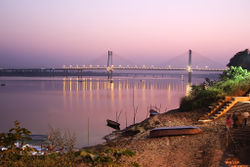 |
|
|
|
|
| Coordinates | |
| Country | |
| State | Uttar Pradesh |
| District(s) | Allahabad |
| Mayor | Ch. Jitendra Nath Singh |
| Population • Density |
1,215,348[1] (2001[update]) • 10,755 /km2 (27,855 /sq mi) |
| Time zone | IST (UTC+5:30) |
| Area |
113 km2 (44 sq mi) • 98 metres (322 ft) |
Allahabad (Hindi: इलाहाबाद, Urdu: اللہآباد), or City of God in Persian, also known as Prayag (Hindi: प्रयाग, Urdu: پریاگ), is a city in the North Indian state of Uttar Pradesh and administrative headquarters of Allahabad District. The ancient name of the city is Prayag (Sanskrit for "place of sacrifice") and is believed to be the spot where Brahma offered his first sacrifice after creating the world. It is one of four sites of the mass Hindu pilgrimage Kumbh Mela, the others being Haridwar, Ujjain and Nashik. It has a position of importance in Hindu scriptures for it is situated at the confluence, known as Triveni Sangam, of the holy rivers Ganges and Yamuna, and Hindu belief says that the invisible Sarasvati River also joins here.[2]
Many government offices are present in the city such as the Allahabad High Court, the Principal Accountant General Office (AG office), the Uttar Pradesh Public Service Commission Office, Uttar Pradesh Police Head Quarters (PHQ), headquarters of the North Central Railway, the Regional Office of the Central Board of Secondary Education and the Uttar Pradesh Board of High School and Intermediate Education.Allahabad also houses the headquarter of famous wheeler book shop.Allahabad ranks 8th in terms of purchasing power capacity in northern India.
Allahabad is associated with 7 out of 14 Prime Ministers of India. Jawaharlal Nehru, Lal Bahadur Shastri, Indira Gandhi, Rajiv Gandhi, Gulzarilal Nanda, Vishwanath Pratap Singh and Chandra Shekhar were all either born in Allahabad, were alumni of Allahabad University or got elected from a constituency in Allahabad.[3]
The Government of India has selected Allahabad as one of the mission cities for the Jawaharlal Nehru National Urban Renewal Mission(JNNURM), with the goals of improving urban infrastructure, efficient governance and basic services to urban citizens.[4]
Contents |
Etymology
The name is derived from the one given to the city by the Mughal Emperor Akbar in 1583. The name in Indian languages generally is Ilāhābād; ilah being Arabic for "(a) god" (in this context from Din-i-Ilahi, the religion founded by Akbar), and "-ābād" is Persian for "to construct or to create", which explains the meaning of the name Illahabad as "God's creation" or "city of god;
History
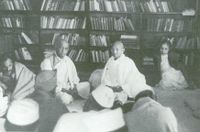
In ancient times, the city was known as Prayag (place of the confluences). According to Hindu religious texts, it is believed to be the where Brahma, the Hindu Creator of the Universe, attended a sacrificial ritual.
For Hindus of India, Prayag and the district of Kaushambi were important parts of their territory. The area became a part of the Mauryan and Gupta empires of the east and the Kushan empire of the west before becoming part of the Kannauj empire.
Allahabad became a part of the Mughal Empire after their invasion of India in 1526. The Mughal emperor Akbar built a magnificent fort in Allahabad. The city was the scene of Maratha incursions before colonial rule was imposed over India.
In 1765, the British established a garrison at Fort Allahabad. In 1857, Allahabad was active in the Indian Mutiny.
The annual convention of the Indian National Congress was held on the extensive grounds of Darbhanga Castle, Allahabad in 1888 and 1892.[5][6]
In 1931, at Alfred Park in Allahabad, the revolutionary Chandrashekhar Azad killed himself when surrounded by the British Police. In the years of the struggle for Indian independence, the Nehru family homes of Anand Bhavan and Swaraj Bhavan, both in Allahabad, were at the center of the political activities of the Indian National Congress. Thousands of satyagrahis (nonviolent resistors) went to jail. The first Prime Minister of India, Jawaharlal Nehru, was from Allahabad.
Geography
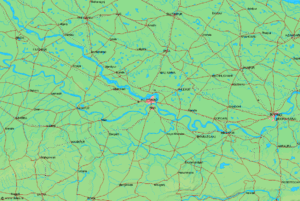
Allahabad is located at in the southern part of the Uttar Pradesh at an elevation of 98 metres (322 ft) and stands at the confluence of the Ganges and Yamuna rivers. The region was known in antiquity as the Vats country. To its southwest is the Bundelkhand region, to its east and southeast is the Bagelkhand region, to its north and northeast is the Awadh region and to its west is the lower Doab region.
Allahabad stands at a strategic point both geographically and culturally. An important part of the Ganges-Yamuna Doab region, it is the last point of the Yamuna River and is the last frontier of the Indian west.
The land of the Allahabad district that falls between the Ganges and Yamuna is just like the rest of Doab, fertile but not too moist, and is especially suitable for the cultivation of wheat. The non-doabi parts of the district, which are the southern and eastern part of the district, are somewhat similar to those of adjoining Bundelkhand and Bagelkhand regions - dry and rocky.
The Indian longitude that is associated with Jabalpur also passes through Allahabad, which is 343 km (213 mi) north of Jabalpur on the same longitude.
Demographics
Allahabad district has a population of 4,936,105 while Allahabad city has a population of 1,206,785 as per the 2001 census. It lists as the 32nd most populous city in India[7].Allahabad literacy rate is 82%. Allahabad has an area of about 70 km2 (27 sq mi)[8] and is 98 m (322 ft) above sea level.
The dialect of Hindi spoken in Allahabad is Awadhi, although Khariboli is most commonly used in the city area. In the eastern, non-doabi part of the Allahabad district Bagheli dialect is more common.
All major religions are practised in Allahabad. Hindus comprise about 85% and Muslims about 12%. There are small groups of Christians, Sikhs and Buddhists.
Climate
| Allahabad | ||||||||||||||||||||||||||||||||||||||||||||||||||||||||||||
|---|---|---|---|---|---|---|---|---|---|---|---|---|---|---|---|---|---|---|---|---|---|---|---|---|---|---|---|---|---|---|---|---|---|---|---|---|---|---|---|---|---|---|---|---|---|---|---|---|---|---|---|---|---|---|---|---|---|---|---|---|
| Climate chart () | ||||||||||||||||||||||||||||||||||||||||||||||||||||||||||||
|
||||||||||||||||||||||||||||||||||||||||||||||||||||||||||||
|
||||||||||||||||||||||||||||||||||||||||||||||||||||||||||||
Allahabad features the atypical version of a humid subtropical climate that is common to cities in north-central India. Allahabad experiences three seasons: hot dry summer, cool dry winter and warm humid monsoon. The summer season lasts from April to June with the maximum temperatures ranging from 40 °C (104 °F) to 45 °C (113 °F). Monsoon begins in early July and lasts till September. The winter season lasts from December to February. Temperatures rarely drop to the freezing point. Maximum temperatures are around 22 °C (72 °F) and minimum around 10 °C (50 °F). Allahabad also witnesses severe fog in January resulting in massive traffic and travel delays. It does not snow in Allahabad.
Lowest temperature recorded, −2 °C (28.4 °F) −2 °C; highest 48 °C (118 °F) 48 °C.[9]
Civic administration
Municipal Corporation of Allahabad (also called Allahabad Nagar Nigam), is one of the old municipalities of the state. The corporation came into existence in 1864[8], when Lucknow Municipal Act was passed by Government of India. City municipal area is divided in total 80 wards and a member (the Corporator) from each ward is elected to form the Municipal Committee[10]. The Corporators elect the Mayor of city. The chief executive is the Commissioner of Allahabad who is appointed by the state government.
Cityscape
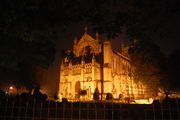
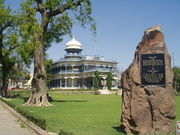
Allahabad is situated at the confluence of the Ganges and Yamuna rivers. It encompasses a large area and is an inland peninsula surrounded by rivers on three sides with only one side connected to the mainland. Because of this fact, to handle growing traffic and connectivity demands, Allahabad has many bridges crossing rivers the Ganges and Yamuna.
The urban area of city can be classified into three categories:- 1]The Old City is economic center of city. This is a high density area where major roads are used as transport corridors as well as market streets. 2]The newer city around Civil Lines area, was conceived during British rule. This area is well planned on gridiron road pattern with additional diagonal roads, making it an efficient city. It is a low density area with wide tree-lined avenues. It houses major educational institutions, the High Court, Uttar Pradesh public service commission, offices, gardens and cantonment areas. It also has shopping malls and multiplexes, namely, Atlantis Mall[inox/fame multiplex] and Vinayak City Centre Mall[pvr multiplex]. 3]The outer growth areas include satellite towns along major highways passing through cities. It also includes city areas trans Ganges and Yamuna. Many real estate developers are investing in Allahabad, prominent being Omaxe,ansals etc. A hi-tech city with an area of 1535 acres is being built in the satellite city of Naini by omaxe group called as "omaxe waterfront". Allahabad has good medical colleges ,hospitals and up to the mark medical facilities. some of the hospitals are- swarooprani hospital,kamala nehru hospital,railway hospital,tej bahadur sapru hospital,state cancer treatment hospital,motilal nehru hospital[all government hospitals] and there are many private hospitals, prominent are jeevan jyoti hospital,anand hospital,bhola hospital ,preeti hospital,apollo clinic etc. allahabad has an allopethic medical college,a homeopaethic medical college ,an unani and two ayurvedic medical college
Places
There are several sports complexes that can be used by both amateurs and professionals. These include the Madan Mohan Malaviya Cricket stadium, Mayo Hall Sports Complex and the Boys' High School & College Gymnasium. There is an international level swimming complex at georgetown .There is a famous national sports academy at jhalwa[allahabad west] which produces world class gymnasts,the academy has been chosen as the flagbearer of Indian gymnastic in forthcoming commonwealth games.
Some places of interests in Allahabad are:
- Sangam and surroundings, particularly in December to February, when Kumbh Mela is going on.
- Anand Bhavan and Jawahar Planetarium.
- New Yamuna Bridge, Yamuna bank road.
- Company Bagh, Alfred Park and Allahabad Museum.
- Allahabad High Court building
- All Saints Cathedral - was built in Century Gothic Style in 13th Century. Also commonly known as Patthar Girja Ghar, this cathedral stands at a prominent location of the city in lush green premises. It figures among the finest Cathedrals of India. Though it was consecrated in 1887, it took another 40 years for it to be completed.
- Allahabad University, established on 23 September 1887, is the fourth oldest University of India after Calcutta, Bombay and Madras University. Its sprawling 320 acre campus in the middle of the city has many heritage buildings.
- Ewing Christian College - American and Victorian Era architecture; the College was established by American Presbyterians in 1902 by the banks of the river Yamuna.
Architecture
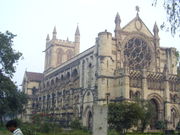
The imprint of Britishers and Mughals can be seen in buildings, gardens and places in Allahabad. The styles of buildings reflect a good mix of western Gothic and Mughal architectures.
All Saints Cathedral, designed by great English architect William Emerson who also designed Victoria Memorial of Calcutta. This cathedral is the most beautiful building in city. Styled in 13th Century Gothic architecture, building's interior is more beautiful than its exterior with high ceilings and stone Gothic arches[11].
Muir College (1874), designed by William Emerson, in Indo-Saracenic architecture, an excellent mix of Gothic and Indian architectural elements. Its foundation was laid in 1874 and opened in 1886. It has an arcade quadrangle, which is dominated, by a 200 feet minaret tower in cream coloured sandstone from Mirzapur with marble and mosaic floors. The domes of the Indo-Saracenic structure are clad in Multan glazed tiles.
University Science Faculty buildings have classical architectural designs and have strong Victorian and Islamic style architectural influences.
Allahabad High Court (1916) - Chief Justice, Sir John Staley laid the foundation in 1911. It was finally completed in 1916 and opened by Viceroy Lord Chelmsford. Designed by Frank Lishman. this structure is subtly adapted to the climate as is evident from the double roofing with tiles from Allahabad on top to beat the summer heat. Conceived in a grand fashion, it has a domed pediment centre, arcade wings, stone balustrades and engrained arches. It reflects a beautiful synthesis of Eastern and Western architectural styles.
Khusro Bagh - The three sandstone mausoleums within this walled garden, present an exquisite example of Mughal architecture.
Public Library (1864)- Standing at Alfred Park it is a beautiful building designed by R.Roskell Rayne. This public library is another remarkable example of Gothic Style. The memorial has a lofty tower and accorded cloisters.
The Old High Court and Public Offices - They are four-storied block. Made of sandstone and ashore these were built by Colonel Pile in I 870 in the classical style. The Minto Park to the west of the ton has a Memorial Pillar enriched with Royal medallions and four lions carrying the Imperial coronet. This was a memorial pillar to the Royal Proclamation of the assumption of rule by the British crown in 1858. The Municipal Museum adjoining the library is yet another colonial structure that is a treasure-trove of archaeological artifacts.
The new Yamuna bridge built jointly by Hindustan Construction Company and Hyundai Engineering and Construction, is India's first cable stayed four lane road bridge in India, representing modern design structure.[12] This large bridge has two pylons made of concrete, which support a large part of bridge deck with the help of attached steel cables.
Transportation
Air
Allahabad is served by the Allahabad Airport (Bamrauli Air Force Base) (IXD) and is linked to Delhi and Kolkata (Calcutta) by JetLite and Air India Regional. Other larger airports in the vicinity are at Varanasi (Varanasi Airport 142 km (88 mi)) and Lucknow (Amausi International Airport 210 km (130 mi)).
Road
National Highway 2 runs through the middle of the city. National Highway 2 is also proposed as one of the routes of Golden Quadrilateral Highway, Delhi-Kolkata section, but it runs out of the city through newly constructed bypass. National Highway 96 connects to NH 28 at Faizabad. Another is National Highway 27 which is 93 km (58 mi) long and starts from Allahabad and ends at Mangawan in Madhya Pradesh connecting to National Highway 7. A four lane access controlled bypass road of 84.7 km aided by World Bank is completed.[13] This will not only reduce transport constraints but will also de-congest heavy transport traffic passing through middle of city. There are other state highways that link Allahabad to all other parts of the country. Allahabad has two bus stations catering to different routes - at Leader Road and Civil Lines. A number of road bridges on rivers Ganges and Yamuna have been built to connect Allahabad with its suburb towns like Naini, Jhusi etc. A new eight lane access controlled expressway - Ganga Expressway is also proposed to pass through Allahabad.[14] A 8 laned outer ring road is proposed in the allahabad district. City buses, Tourist taxis, auto rickshaws (or tempos) are available for local transport. There is also a local bus service that connects various parts of the city. But the most convenient method of local transport is the cycle rickshaw.National Highway 76, 76 Extn. and 24B connects to Rajasthan state, Mirzapur and Lucknow respectively.
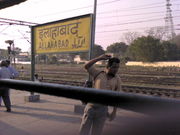
.
Train
Served by Indian Railways, Allahabad is the headquarters of the North Central Railway Zone, and is well connected by trains with all major cities, namely, Kolkata, Delhi, Mumbai, Chennai, Hyderabad, Indore, Lucknow, Bhopal, Gwalior, Jabalpur, Bhubaneswar, Cuttack Bangalore and Jaipur. Allahabad has eight railway stations with in its city limits namely Prayag , Allahabad City (Rambagh), Daraganj, Allahabad Junction, Naini Jn, Prayag Ghat, Subedar Ganj & Bamrauli.
Education
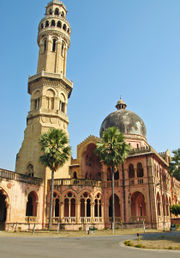
Allahabad attracts students and learners from all over country. Allahabad has one central university, three deemed universities,an open university, research and technical institutions and colleges known for providing higher education in vast range of disciplines. Few of the reputed ones can be listed as following.
- Motilal Nehru National Institute of Technology (MNNIT) Allahabad, a deemed university, one of the twenty National Institutes of Technology and an Institute of National Importance of India.It is consistently ranked among top 20 engineering colleges in India.
- Indian Institute of Information Technology, Allahabad [IIIT-A] is a center of excellence in computer science and allied areas established by MHRD, Government Of India. It was conferred the Deemed University status in 2000.
- Allahabad University founded in 1887 is the fourth oldest university of India, is granted Central University status.
- J.K. Institute of Applied Physics & Technology, University of Allahabad (JK) is one of the oldest Engineering Institutes of India offering B.Tech, M.Tech and higher courses in the field of Electronics & Telecommunications. The foundation stone of JK Institute was laid by late PM Jawahar Lal Nehru in 1946-47 and the building in which the Institute is housed is an architectural marvel itself. The building is an integral part of the Science Department of the University. The Institute also offers courses in the Field of Computer Science (B. Sc, M.Sc and higher degrees) and has the distinction of being one of the sponsored institutes of Defence Research & Development Organisation (DRDO).
- Uttar pradesh rajarshi tandon open university, is situated in phaphamau[allahabad north].it is the lone open university of uttar pradesh *Allahabad Agricultural Institute, a Deemed University,established in the Year 1910 is the oldest such institute in South Asia.Now been reckoned as Sam Higginbottom Institute of Agriculture, Technology & Sciences (SHIATS).
- Harish-Chandra Research Institute is an institute funded by Department of Atomic Energy, Government of India, dedicated to research in Mathematics and Physics.
- Motilal Nehru Medical College it is one of the seven medical colleges in uttar pradesh.It has swarooprani hospital attached to it.people from far flung areas come here for treatment .
- Birla Institute of Technology Allahabad is an extension center of Birla Institute of Technology of Mesra (Ranchi) - BIT. India Today magazine cited both - BITS (Pilani) and BITS (Ranchi) among the 10 best engineering institutions of India.[15][16]
- Institute of Engineering and Rural Technology (IERT) Allahabad, was established to provide diploma courses in various engineering disciplines, now offers degree courses also from Uttar Pradesh Technical University.
- Ewing Christian College founded in 1902 is the only Autonomous Minority Co-Educational College of the Allahabad University. The College was established by The American Presbyterians visiting India on Christian Mission. The Church of North India is the main controlling body, and the Bishop of the Lucknow Diocese stands the grand Chairman on the College. The campus is beautifully situated along the Yamuna River as a symbol of the grandeur of this historic city.
- B.B.S college of Engg.and Technology is a rapidly growing institute of high standard It has also branches in GR.NOIDA.It is located in the phapamau region across the river ganga . It provides student a high quality education and is among the best of the engineering institute located in the city.Rapidly growing in terms of facility and education quality .
- United Group of Institutions Established more than a decade back with merely a single degree college, this rapid-growing educational society has traveled a long journey right from a small institute at a commercial venue to a vast extensive campus comprising of seven colleges in a row imparting quality education in the field of Engineering, Pharmacy, Architecture, Management & Computer Application,affiliated to UP Technical University, Lucknow.It has also branches in GR.NOIDA.Besides there are 15 engineering colleges affiliated to uptu.
There are many government aided and private schools and colleges in Allahabad which are affiliated with either the Indian Certificate of Secondary Education (ICSE), the Central Board for Secondary Education (CBSE), or the UP Board of High School and Intermediate Education. Allahabad is one of the regional divisions of CBSE and head office of UP Board of High School and Intermediate Education. English is the medium of instructions in most private schools while government aided schools and colleges offer both Hindi and English medium education. Boys' High School and College, Bishop Johnson School & College, St Joseph's College, Maharshi Patanjali Vidya Mandir, Delhi Public School, St Mary's Convent School, Girls' High School, Government Intermediate College and Colonelganj Intermediate College, Bethany Convent School and Jagat Taran Golden Jubilee School are some of the reputed schools in city.
To cater needs of vocational, technical and professional education in rural areas of Allahabad and nearby districts, the Ministry of HRD, Government of India has recently started another university named[17] at Dubawal village of Allahabad. The university currently offers academic programs at graduate and post graduate levels in various disciplines including Arts, Commerce, Science, Education (as subject), Law, Management, Rural Development, Master of Social Works, Computer Applications, Journalism etc.[18].
Industries
Allahabad has glass and wire based industries. The main industrial area of Allahabad is Naini and Phulpur,where several public and private sector companies have their units, offices and factories. These include Areva T&D India (a division of multinational Areva Group), Bharat Pumps and Compressors Limited (BPCL), Indian Telephone Industry (ITI), Reliance Industries - Allahabad Manufacturing Division, Hindustan Cables, Triveni Structurals Limited (TSL, a subsidiary of Bharat Yantra Nigam), Glass Factory etc. Indian Farmers Fertilizer Co-Operative IFFCO is situated in the Phulpur area. IFFCO's Phulpur complex has two production units and is the world’s largest fertilser complex based on naphtha as feed stock. Three mega thermal power projects are coming up at Meja, Bara and Karchna tehsils of district being constructed by JP Group and National Thermal Power Corporation.
Sports
Allahabad has a prominent place in Indian gymnastics. It is the leading team in SAARC and Asian countries. Khelgaon Public School at Jhalwa, Allahabad provides training in gymnastics; its gymnasts won two gold and three silver medals at 33rd Tulit Peter Memorial Cup-2007 held in Hungary. The hockey player Dhyan Chand was born on August 29, 1906, in Allahabad; he won gold medals in three successive Olympic games: Amsterdam (1928), Los Angeles (1932) and Berlin (1936). Sunil Kumar and Mohammed Kaif, the Indian cricket player, is from Allahabad. Another prominent sporting personality is Abhinn Shyam Gupta who won the national title of badminton in 2002.Ratan Singh of lohra got international bhabhua handicapped kabaddi championship in year 1857 when india was fighting and revolting against britishers.
Notable people from Allahabad
- Madan Mohan Malaviya (freedom fighter)
- Motilal Nehru (advocate and politician)
- Amitabh Bachchan (actor)
- Jawaharlal Nehru (politician and Prime Minister)
- Indira Gandhi (Prime Minister)
- G. R. Sharma (historian)
- Harish Chandra (physicist, mathematician)
- Manindra Agrawal (computer scientist)
- Mriganka Sur (cognitive scientist)
- Murli Manohar Joshi (politician, former cabinet minister)
- Mukhtar Abbas Naqvi (politician, former cabinet minister, Vice President-BJP)
- Harivansh Rai Bachchan (poet)
- Suryakant Tripathi 'Nirala' (Hindi poet)
- Vibhuti Narain Rai (writer)
- Mahadevi Varma (poet and writer)
- Firaq Gorakhpuri (Urdu poet)
- Dhyan Chand (hockey player)
- Maulvi Liaquat Ali (freedom fighter)
- Sunil Pandey "Prince"(Student Leader,ALLAHABAD UNIVERSITY )
- Mohammad Kaif (cricket player)
- Maharishi Mahesh Yogi (spiritual leader)
- Ravindra Khattree (academic statistician)
- Purushottam Das Tandon (politician and freedom fighter)
- Shubha Mudgal (singer, Hindustani classical music)
- V. P. Singh (former Prime Minister of India)
- V. N. Khare (former Chief Justice of India)
- Dharmveer Bharti (Hindi writer)
- Vinod Rastogi (Hindi play writer )
- Dhirendra Verma (Hindi poet)
- Ramkumar Verma (Hindi poet)
- Akbar Allahabadi (Urdu poet)
- Vikas Swarup (novelist)
- Rehana Sultan (film actress)
- Hariprasad Chaurasia (classical instrumentalist)
- Sumitranandan Pant (Hindi poet)
- Hemwati Nandan Bahuguna (former chief minister of Uttar Pradesh)
References
- ↑ [1] Official census data of Indian cities as of 2001
- ↑ http://www.allahabad.nic.in/
- ↑ http://www.up-tourism.com/destination/allahabad/about.htm
- ↑ Mission Cities at http://jnnurm.nic.in/nurmudweb/missioncities.htm
- ↑ The Congress – First Twenty Years; Page 38 and 39
- ↑ How India Wrought for Freedom: The story of the National Congress Told from the Official records (1915) by Anne Besant.
- ↑ http://www.citymayors.com/gratis/indian_cities.html
- ↑ 8.0 8.1 http://allahabadnagarnigam.in/english/about_nagarnigam_allahabad.htm
- ↑ Weatherbase.com
- ↑ http://allahabadnagarnigam.in/english/governingbody.htm
- ↑ Architecture of All Saints Cathedral http://www.allsaintscathedralallahabad.com/ARCHITECTURE.htm
- ↑ refer KEY FACTS by HCC http://www.hccindia.com/core_business_inner.php?page=core_business&id=3
- ↑ India - Allahabad Bypass Project http://web.worldbank.org/WBSITE/EXTERNAL/PROJECTS/0,,contentMDK:20133102~menuPK:64282137~pagePK:41367~piPK:279616~theSitePK:40941,00.html
- ↑ http://www.constructionupdate.com/products/projectsinfo/2008/28-Julyto3rd-August-2008/013.html
- ↑ Exclusive India Today-Gallup Survey http://www.india-today.com/itoday/20010521/cover-engineering.shtml
- ↑ http://www.india-today.com/itoday/20010521/coverengineering.html
- ↑ http://www.nehrugrambharati.org.in/index.html Nehru Gram Bharti Vishwavidyalaya
- ↑ Program details of Nehru Gram Bharti Vishwavidyalaya http://www.nehrugrambharati.org.in/admission-programme--procedure.html
a.k singh
External links
- Official website of Allahabad
- St. Joseph's College
- Allahabad Development Authority
- Allahabad Nagar Nigam (Municipal Office)
- High Court Allahabad
- Board of High School and Intermediate Education Uttar Pradesh, Allahabad
- Allahabad travel guide from Wikitravel
- Allahabad at Wikimapia - Showing places, geography, terrain, routes in and around Allahabad using satellite images
- All Saints Cathedral (Pathar Girjaghar), Allahabad
|
|||||||||||||||||||||||||||||||||||||||||||||||||||||||||||||||||||||||||||||||

